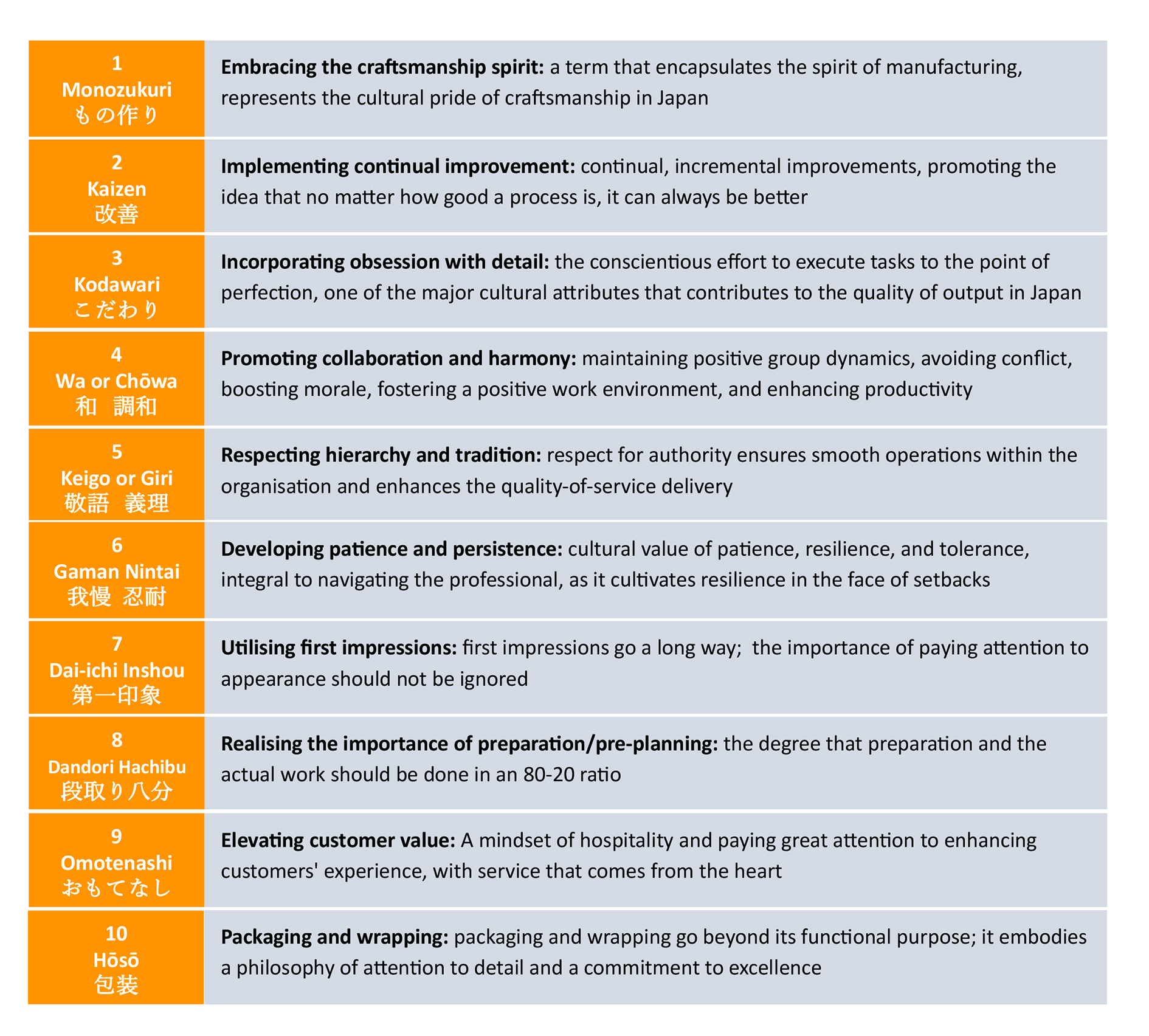
Exploring hidden dimensions Part 6: another look at the double-edged sword
Progress indicator

Continuing their series, IRCA-certified Associate Auditor and International Project Quality Lead Rasoul Aivazi and retired auditor Richard Brett explore how Japanese philosophies are intrinsic in quality.
Rasoul Aivazi is a committee member of the CQI Audit and Deming SIGs, while Richard Brett had roles as Japan Quality SME and Audit Manager for GSK, and is currently Vice-Chair of the Audit SIG.
As outlined in Part 5 of this series the term ‘double-edged sword’ is used to describe a situation or decision that has both positive and negative consequences or effects.
The 10 cultural influences that offer a roadmap for professional success in Japan are discussed in Part 3 and Part 4 of this series and are summarised in Table 1, below.

The nuanced advantages and disadvantages of the cultural attributes listed from 3) Incorporating obsession with detail, to 7) Utilising the first impressions are discussed in Part 5 of this series. T
his section covers 8) Realising the Importance of preparation to 10) Packaging and wrapping, then proceeds to ‘best practices to prevent potential drawbacks’ and ‘moving forward’, which aim to provide key takeaways from Parts 5 and 6.
The importance of preparation/pre-planning (dandori hachi-bu, shigoto ni-bu): This Japanese proverb, translating to ‘eight parts preparation, two parts execution’, underscores the critical role of meticulous planning and organisation in achieving successful outcomes. It reflects a deep-seated belief in the value of methodical and detailed preparation before any action is taken.
Advantage: encourages thorough preparation and strategic planning, which can lead to more efficient execution and higher-quality outcomes. It fosters a culture where every detail is considered, and risks are assessed and mitigated in advance, leading to smoother project flows and more predictable results.
Drawback: an excessive focus on preparation can lead to decision paralysis, where actions are delayed because of overanalysis.
Elevating customer value (omotenashi) :The Japanese ethos of hospitality is the selfless anticipation of a guest's needs.
Advantage: in business, this translates to excellent customer service, stakeholder management, and a genuine commitment to stakeholder wellbeing.
Drawback: such an approach might set unsustainable expectations or lead to over-accommodation, sometimes to the detriment of the service provider's wellbeing.
"The challenge is not just understanding these cultural nuances, but navigating them skillfully to foster personal and organisational growth."
Packaging and wrapping (hōsō): This is the art of presentation and packaging (often seen in the meticulous way gifts are wrapped).
Advantage: ensures products and services are presented at their absolute best, amplifying perceived value. Drawback: overemphasis on presentation can overshadow the priority of the actual quality or functionality of a product or service.
Best practices to prevent potential drawbacks
While the Japanese culture of quality emphasises the importance of treating customers with the utmost respect and prioritising their satisfaction, it is essential for businesses to strike a balance to avoid undue stress and maintain a healthy work environment.
Here are some ways in which businesses can implement this belief effectively:
- Active listening and continual training
Encourage staff to listen attentively to customers, acknowledging their concerns and needs. Active listening builds trust and helps businesses understand and address customer pain points more effectively.
Invest in regular training programmes to equip employees with the skills and knowledge to cater to customers effectively while maintaining a balanced approach.
- Feedback mechanisms
Feedback helps businesses improve and adapt to changing customer needs, ensuring long-term satisfaction. Establish multiple channels for customers to provide feedback.
- Set clear boundaries with clients, and protect employee wellbeing
Not every demand or request from a customer is feasible – or reasonable. Clear boundaries ensure that, while customers are respected, the business and its employees are not exploited or overextended.
Check in on employee wellbeing regularly, provide necessary support, and establish mechanisms where employees can voice concerns. A satisfied and well-supported employee is better equipped to serve customers and uphold the belief in customer satisfaction.
Manage expectations
While always aiming to deliver exceptional service, it is crucial to set realistic expectations. Communicate to customers what can be achieved realistically – managing expectations ensures customers are not left disappointed and businesses do not overcommit.
Encourage open communication with customers. Rather than just serving, aim to establish a healthy, honest and more equal relationship. This will foster long-term loyalty and help businesses better understand customers’ needs.
Innovation
Promote innovation by engaging with customer needs and feedback. Innovation ensures businesses remain relevant and can serve customers better in an environment where market dynamics change frequently.
Regular assessment
Regularly assess business practices to ensure they align with the ethos of omotenashi without compromising on employee wellbeing or business sustainability. This will ensure that the business remains committed to customer satisfaction, while addressing any potential issues early on.
Moving forward
The insights from seasoned and younger Japanese professionals underscore the nuanced nature of Japan's business culture, revealing a landscape where reverence for tradition coexists with the urgent need for innovation and global competitiveness.
The 10 cultural influences, discussed in Part 3 and 4 of this series, offer insights into the Japanese professional psyche, emphasising meticulous planning, respect for hierarchy, a commitment to quality, and unparalleled customer service.
However, taken to extremes, these same virtues can become impediments, stifling flexibility, innovation and individuality. The challenge, therefore, is not just understanding these cultural nuances, but navigating them skillfully to foster personal and organisational growth.
The dialogue between traditional and contemporary, local and global, is not unique to Japan, but is perhaps more pronounced, given the country’s history of isolationism and subsequent rapid modernisation.
Reflections from Japanese professionals, young and old, suggest a collective aspiration to redefine their work culture. This entails embracing the positive, while critically addressing the limitations, ensuring that the cultural qualities that have long defined Japanese business do not become constraints in a fast-paced, ever-changing global environment.
Moreover, the discussion extends beyond the professional realm, touching on broader societal implications. The alarming phenomenon of ‘death from overwork’ (Japanese term 過労死 karoshi), the changing dynamics of customer service, and the evolving concept of teamwork and leadership all point towards a society in transition. These reflections offer invaluable lessons, not just for those working in Japan, but for anyone interested in the complexities of cultural adaptation and international business.
Conclusion
The path forward for Japan's professional landscape is not paved with easy answers, but with thoughtful questions.
The current generation’s willingness to engage with these questions, to challenge the status quo while respecting their cultural heritage, is perhaps the most promising sign of all. It suggests a future where the double-edged sword of cultural tradition and innovation is wielded not with trepidation, but with precision, balance and foresight.
The journey through Japan's working culture is testament to the dynamic interplay between endurance and adaptability. For professionals looking to succeed in this environment, embracing the depth and complexity of Japanese cultural values, while fostering a spirit of flexibility and innovation, is key.
As global and local environments intersect more than ever before, the ability to navigate this delicate balance will define the next chapter of professional success in Japan.
As Japan continues to evolve, so too must our understanding and engagement with its business culture. By embracing change while honoring tradition, new pathways to success, collaboration, and mutual respect can be forged, benefiting not just individuals and organisations, but society as a whole.
The journey through Japan's hidden dimensions is ongoing, and for those willing to explore, it promises rich rewards and profound insights.
This series will continue with quality stories drawn from the authors' own experiences in Part 7: 'Exploring Hidden Dimensions – every advantage comes with a drawback’.
Acknowledgement: This part of our series has undergone review and comment by a distinguished team, Hiroyuki Iwamoto (岩本博之), Ryo Kanno (菅野亮), Shinya Watanabe (渡邉慎也), and Toshihiro Koga (古賀稔広). The authors acknowledge and sincerely value the significant contributions and expertise they have provided.
Have you missed any of this series?
Catch up on the previous parts of this series, starting at the beginning
Quality Live 2024 recordings now available

Access recordings from all twelve Quality Live 2024 sessions on Digital Transformation, Culture, and Skills.
Quality World

Get the latest news, interviews and features on quality in our industry leading magazine.


